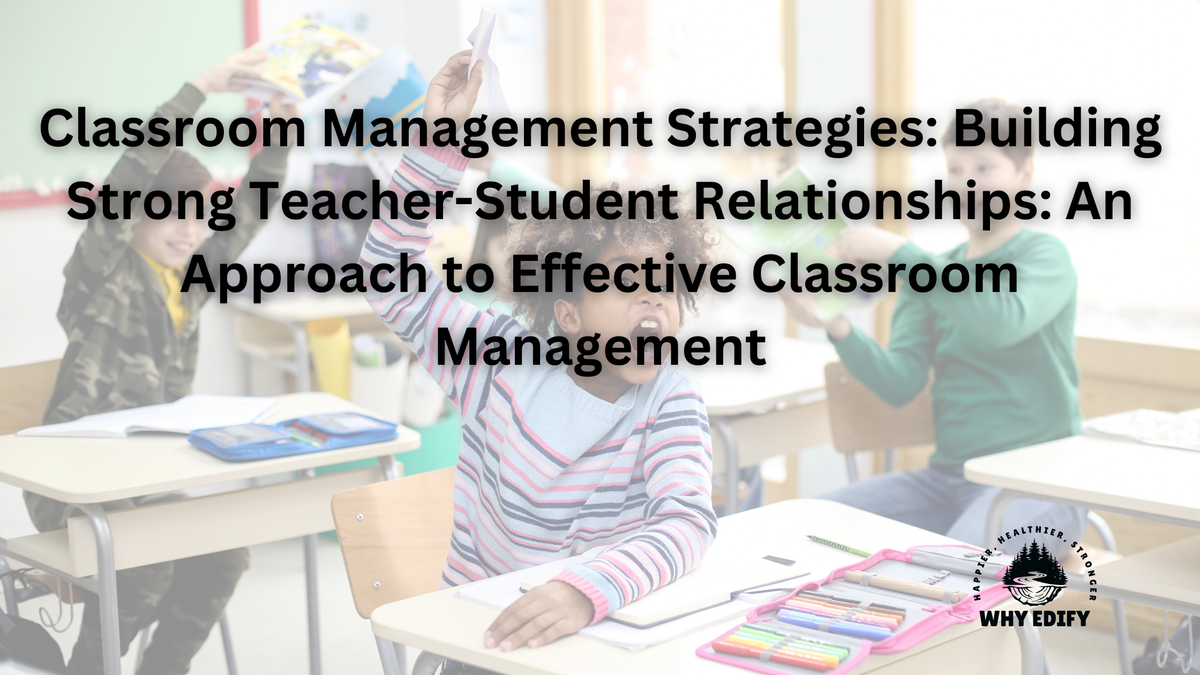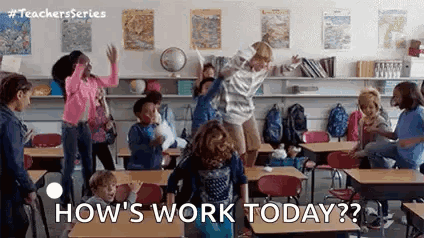Classroom Management Strategies: Building Strong Teacher-Student Relationships - An Approach to Effective Classroom Management
Discover how the Establish-Maintain-Restore (EMR) approach can reduce classroom disruptions by 75% and boost engagement by 33%. Learn practical strategies for building lasting teacher-student relationships and creating a positive learning environment.

Classroom Management Strategies: Building Strong Teacher-Student Relationships - An Approach to Effective Classroom Management
Support Why EdifyMy mission with Why Edify is to help teachers become happier, healthier, and stronger. I believe that when you strengthen your classroom management skills, you are far more likely to enjoy your job as a teacher. It's the cornerstone of a long and productive teaching career. Here is the first post in my classroom management series designed to help you continue to improve your ability to handle behavior challenges in the classroom and direct a classroom effectively.
The foundation of effective classroom management isn't about strict rules or perfect silence - it's about building meaningful relationships with students. While this may sound like a cliché, it's repeated so often because it's true. Research has shown that strong teacher-student relationships can dramatically reduce classroom disruptions by up to 75% while boosting academic engagement by 33%.
Important: It's never too late to try something new. Think of your classroom as a laboratory where you keep experimenting until it turns out how you want it to.

Let's explore proven strategies for creating these important connections:
The Establish-Maintain-Restore Approach
This three-phase strategy provides a framework for building and sustaining positive relationships throughout the school year. Here's how it works:
1. Establish Strong Initial Connections
The early weeks of school are crucial for relationship building. To establish strong connections, teachers can implement several successful strategies. First, schedule one-on-one meetings with students through brief 5-minute check-ins during the first week. Simple, informal connections will do if you have a large class load.
These meetings, held before or after class or during lunch, provide opportunities to discuss academic goals, interests, and learning preferences in a casual, conversational way. Use engaging icebreaker questions like "What's your favorite hobby?" or "What do you hope to learn this year?" to understand students' interests, goals, and values. Keep detailed digital records of these conversations to personalize instruction throughout the year.
Even though starting the year with this approach makes things easier, it’s never too late to change course and make relationship building a priority.
Student-led activities are another powerful way to build relationships. Have students teach mini-lessons on topics they're passionate about, allowing them to prepare short presentations on their favorite hobbies or interests. Create "expert groups" based on shared interests where students can demonstrate their knowledge to peers. Additionally, empower students to lead morning energizers or brain breaks, letting them choose from a menu of movement activities or mindfulness exercises.
Welcoming daily routines form the foundation of a supportive classroom environment. Begin each day by greeting students individually at the door (more below). End the day with "appreciation time," allowing students to recognize their peers' contributions through written notes or verbal shout-outs. Track these recognitions on a classroom "Kindness Wall" to reinforce positive behaviors and build a strong classroom community.
2. Maintain Positive Interactions
Consistency is key to maintaining these relationships. Research suggests maintaining a 5:1 ratio of positive to negative interactions - this means for every correction or redirection, you should have five positive interactions with that student. These positive interactions don't need to be elaborate; they can include specific praise for academic effort (like noting a student's persistence in solving a math problem), recognition of helpful behaviors (such as assisting classmates), brief personal connections (like mentioning their recent sports game), or even simple non-verbal positives like smiles and encouraging nods.
A simple yet powerful practice is greeting students at the door. This small, repetitive action is powerful. Research has shown this brief daily connection can increase academic engagement by 20% and reduce disruptive behavior by 9%. To maximize the impact of these greetings, make sure to use students' names and maintain eye contact. Keep the greetings fresh by varying your approach each day, and use this brief moment to watch for signs that might indicate a student needs extra support. This is also an excellent opportunity to quickly follow up on previous discussions or show interest in students' activities and achievements outside the classroom.
3. Restore When Needed
When conflicts arise, it helps to take a constructive approach to resolution. Rather than dwelling on problems like repeated tardiness, work collaboratively with students to identify underlying issues such as transportation challenges and develop practical solutions like improved morning routines. Show genuine empathy by recognizing students' circumstances - for instance, when a student has difficulty focusing due to home situations, offer appropriate support and accommodations. It's also important to model accountability by taking responsibility when appropriate, such as acknowledging when you could have provided clearer instructions or checked in with a student earlier. Also, use specific language that addresses the behavior rather than labeling the student. Instead of saying, "You're being disruptive," explain how "talking during instruction makes it hard for others to learn" and collaborate on finding alternative ways for the student to participate constructively in class. Whenever possible, work with students one-on-one to address behaviors. It’s much easier to maintain relationships this way.
Elementary School Application: At the elementary level, restoration often involves concrete, age-appropriate strategies. For example, when students consistently have trouble during transitions, create a visual schedule with pictures showing each step. Use "peace corners" where students can calm down and reflect using emotion cards or drawing materials. Implement simple conflict resolution scripts like "I feel... when... because..." to help young students express their needs. Consider using puppet role-play to demonstrate and practice positive behaviors.
Middle School Application: For middle school students, restoration requires acknowledging their growing independence while providing structured support. Create private reflection sheets that guide students through analyzing their choices and brainstorming alternatives. Implement peer mediation programs where trained student leaders help resolve conflicts. Use collaborative problem-solving sessions where students and teachers work together to create behavior contracts or set personal goals. Remember that middle schoolers are particularly sensitive to peer perception, so always maintain dignity in correction.
High School Application: High school students benefit from more sophisticated restoration approaches that treat them as young adults. Hold one-on-one conferences that focus on real-world implications and future success. Develop student-led restorative circles where peers can discuss and resolve classroom issues. Create opportunities for students to make amends through meaningful actions, such as tutoring younger students or contributing to class projects. Emphasize personal responsibility while showing respect for their autonomy and decision-making capabilities.
The Human Element
Remember that effective classroom management starts with genuinely caring about students as individuals. Every student, regardless of age, needs to feel seen, heard, and valued for who they are. When prioritizing relationships over rules, we create an environment where learning occurs naturally.
A crucial aspect of this approach is offering students a fresh start after behavioral incidents. Allowing students to "reset" after infractions demonstrates our belief in their capacity for growth and change. This reduces anxiety and shame and encourages students to take responsibility for their actions without feeling permanently labeled by past mistakes.
By investing in these relationships and maintaining an environment of second chances, you're not just managing a classroom - you're building a community of learners who feel supported, respected, and ready to engage in their education while knowing it's safe to learn from their missteps.
What are your tried and true tips for managing behaviors? Leave them in a comment below.
❤ Enjoy this Article?
🍵 Show Your Support and 🤗 Share It



